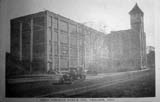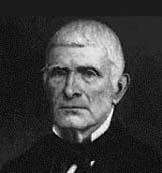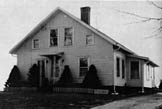|
|
||||||||||||
Seth Thomas
The Thomas Homestead |
||||||||||||

Seth Thomas Clock Company
in Thomaston, Connecticut
(click to enlarge)
 |
 |
|
Seth Thomas Dissertation given by Florence Goodman to the Thomaston Historical Society, April 10, 2000 James Thomas came from Scotland and settled in Farmingbury, now called Wolcott in the late 1700's. He built a one and a half story Cape Cod style, post and beam home (circa 1775) near the James Alcox (Alcott) house on Spindle Hill. He married Martha Barnes, and they had seven children. Seth was the fifth child, and he was born in 1785. The house in which he was born is located on 36 Peterson Lane, which today is just east of the junction of Mad River and Spindle Hill Roads. He lived in that house until about 1810. James Thomas was a cooper by trade, a person who repairs casks and barrels, but he also loved carpentry. From this, Seth probably acquired his interest in carpentry. Seth had a limited formal education and at an early age left school to become a carpenter apprentice to Daniel Tuttle, of Plymouth. It was said that Seth was a man of few words, but great energy and perseverance in any employment in which he engaged. Thus, Seth paid strong attention to the duties of this apprenticeship, and many of the "wild lads" of Wolcott called him "Daniel Tuttle's fool" because of this. After his apprenticeship was completed, Seth became a skillful woodworker and worked building houses and barns in the nearby towns around Wolcott. In the year 1800, Seth attempted to set up a clock-making industry in Wolcott. He made his first clock in his family's house off of Spindle Hill Road. The woods around the house were filled with mountain laurel trees; and many Wolcott men worked cutting the trees and sawing them into thin slices, which, when seasoned, were used for the wooden wheels of the clocks. The women of the town spun flax (cotton) into cords and these were used to hold the clock weights; and so the town of Wolcott profited to some extent from Seth Thomas's enterprise, the short time it was located in Wolcott. Previous to 1807, when Seth Thomas went to work for the firm of Terry, Thomas and Hoadley, at Hoadleyville, he made an offer to a Mr. Daniel Byington, of Wolcott, to purchase mill property on the Mad River. It was believed that the waterpower of Wolcott was superior to that of Plymouth Hollow and this site would have made an excellent location for his mill. He also asked the town to open a road direct to Cheshire for the export of goods that might be manufactured by him. The town did not see the need for such a road and declined his offer, thus, Mr. Thomas became discouraged and went to Hoadleyville, and then on to Plymouth Hollow. In 1807, Seth Thomas joined Eli Terry and Silas Hoadley in a business of making clocks at a wholesale rate. Seth mainly worked on fitting the wheels and different clock parts together. During the years from 1807 until 1810, they made 4000 clocks of the "hang-up" or "wag-on-the wall" type. These clocks did not have cases, but buyers who wanted cases for their clocks hired carpenters to build what they called "grandfather cases" for them. In 1810, Thomas and Terry bought out Hoadley's share of the company and they worked together until 1812. At that time Seth Thomas sold out his share of the company, and went into business on his own in Plymouth Hollow. Thomas also built a mill for rolling brass and making wire that he operated in conjunction with his clock factory. It wasn't until 1853 that the Seth Thomas Clock Company was established. Thomas also purchased the manufacturing rights of the shelf clock from Eli Terry and turned this particular type of clock into a big seller. He mass-produced clocks by using automated methods to build and assemble the components of the clocks. Seth Thomas was married to Philinda Tuttle in the early 1800's. There is little available in our records about his family life, except that he had a son, Seth Thomas, Jr., who went into the clock business with him. It was his son who enlarged the clock factory and developed it into a world business. Seth Thomas died in 1859 in Plymouth. It was at that time that the politicians of Plymouth made the western portion of the town, where the factory was located, into a new town called Thomaston. This information was compiled by Mrs. Florence Goodman, April, 2000 Sources: Badger, Rose Wakelee, Old Wolcott; Orcutt, Rev. Samuel, History of the Town of Wolcott. Connecticut,Waterbury, CT, 1874; Thomas, Seth, Microsoft Encarta 98 Encyclopedia, 1993-97.
|
|
|
[Home]
[News]
[Purpose]
[Calendar]
[Museum]
[Membership]
[History]
[Contacts]
[Links]
All material at Wolcott Historical Society Web sites Copyright © 2000-2021 Wolcott Historical Society |

